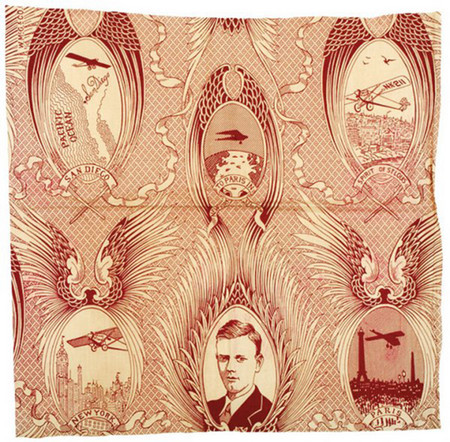Famous figures literally woven into history

Many different drapery fabrics and bed coverings were decorated with pictures of the famous men of the day. Some were made for political campaigns.
A printed fabric of the "Apothesis of Franklin" that pictured both George Washington and Benjamin Franklin was made in 1785. Another showed William H. Harrison, a log cabin and other symbols from the 1840 campaign. Zachary Taylor was shown riding a horse on many different fabrics in the late 1840s.
Fabrics were also made during the campaigns of Ulysses S. Grant (1868) and James Garfield (1880). Horace Greeley was suggested in a fabric decorated with rows of his hat, initials and pipe, but no picture.
Many fabrics picturing past presidents and heroes were made in years celebrating world’s fairs and events like the country’s centennial and bicentennial. There was even a drapery fabric that pictured Charles Lindbergh and his plane after his successful 1927 flight. Collectors tend to think that designs and pictures of past events were made at the earliest possible date. So a fabric showing George Washington must have been made in 1776. Not true. Each national celebration seems to inspire both old and new designs related to U.S. history.
Q: I have an eight-sided "Dr. Cronk Sarsaparilla" bottle and haven’t been able to find any information about it. Can you tell me anything?
A: Dr. Cronk sarsaparilla beer was bottled in both stoneware and glass eight-sided bottles. All of the bottles, as well as Cronk bottles in other shapes, appear to date from the 1840s-’60s. Some experts think the brand name "Dr. Cronk," while originally used by a brewer named Cronk, was later licensed to various manufacturers and bottlers.
A stoneware Cronk bottle in excellent condition sells for $50 or so. A glass bottle sells for at least 10 times as much.
Q: I collect old school slates. I know they wrote on slates instead of paper in schools in past centuries. When did students stop using slates?
A: Slate is still used as blackboards in many school buildings, although new rooms use painted or dry erase boards.
Small pieces of slate, usually framed with wood and bound in red cord, were used by American students until about the 1880s. The cord binding helped keep the slate from making scratching noises when it was dragged across a desktop. Early slates were often marked with the owner’s initials.
Slates for school children were still being sold in some areas in the 1930s.
Q: What does the term "blown out" mean when referring to Wave Crest vases?
A: Wave Crest is an opaque white glassware made around the turn of the 20th century. The glassware line was decorated and marketed by the C.F. Monroe Co. of Meriden, Conn. Most of the glass pieces Monroe decorated were made by the Pairpoint Manufacturing Co. of New Bedford, Mass.
"Blown out" means the same thing as "mold blown." It refers to a technique of blowing glass into a mold that has a deeply cut design. The glass is forced into the design in the mold, resulting in a glass shape with a highly raised surface design. Wave Crest is just one of many types of blown-out glassware.
Tip: Do not store food in a cast-iron pot in the refrigerator. The pot’s seasoning will be harmed by food or moisture.
Terry Kovel’s column is syndicated by King Features. Write to: Kovels, (Las Vegas Review-Journal), King Features Syndicate, 300 W. 57th St., New York, NY 10019.